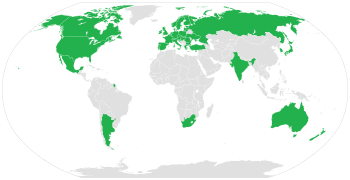
Back Споразумение от Васенаар Bulgarian Compromís de Wassenaar Catalan Wassenaar-aftalen Danish Wassenaar-Abkommen German Acuerdo de Wassenaar Spanish Wassenaari lepingu organisatsioon Estonian Wassenaarin sopimus Finnish Arrangement de Wassenaar French הסדר ואסנאר HE Wassenaari egyezmény Hungarian

The Wassenaar Arrangement on Export Controls for Conventional Arms and Dual-Use Goods and Technologies is a multilateral export control regime established on 12 July 1996, in Wassenaar, near The Hague, Netherlands. According to the Wassenaar Arrangement document, it was "established to contribute to regional and international security and stability by promoting transparency and greater responsibility in transfers of conventional arms and dual-use goods and technologies, thus preventing destabilizing accumulations. Participating states seek, through their national policies, to ensure that transfers of these items do not contribute to the development or enhancement of military capabilities which undermine these goals, and are not diverted to support such capabilities".[1]
It is the successor to the Cold War–era Coordinating Committee for Multilateral Export Controls (CoCom). The Wassenaar Arrangement is considerably less strict than CoCom, focusing primarily on the transparency of national export control regimes and not granting veto power to individual members over organizational decisions. A Secretariat for administering the agreement is located in Vienna, Austria. Like CoCom, however, it is not a treaty, and therefore is not legally binding.[2]
Every six months member countries exchange information on deliveries of conventional arms to non-Wassenaar members that fall under eight broad weapons categories: battle tanks, armoured fighting vehicles, large-calibre artillery, military aircraft, military helicopters, warships, missiles or missile systems, and small arms and light weapons.
There are 42 participating states including many former Comecon (Warsaw Pact) countries, including Russia.[3]
- ^ "Wassenaar Arrangement on Export Controls for Conventional Arms and Dual-Use Goods and Technologies - Basic Documents" (PDF). Wassenaar Arrangement Secretariat. January 2015.
- ^ "The Wassenaar Arrangement at a Glance | Arms Control Association".
- ^ "Wassenaar Arrangement | Nuclear Threat Initiative".